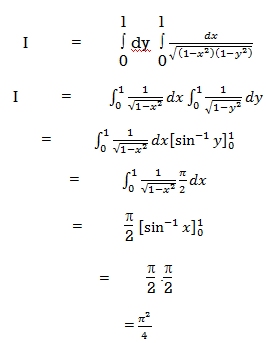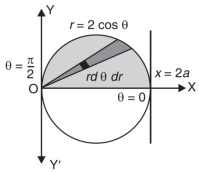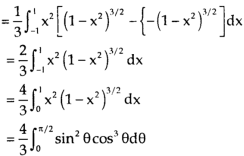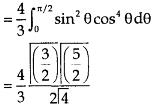Unit - 2
Extrema of functions of two variables
Q1) Define relative maximum and relative minimum.
A1)
Relative maximum
Relative maximum: f (x, y) is said to have a relative maximum at a point (a, b) if
f (a, b) > f (a + h, b + k)
For small positive or negative values of h and k i.e., f (a, b) the value of the function f at (a, b) is greater than the value of the function f at all points in some small neighbourhood of (a, b).
Relative minimum-
f (x, y) has a relative minimum at (a, b) if
f (a, b) < f (a + h, b + k).
Q2) What are the maxima and minima of a function of two independent variables.
A2)
Let  be a defined function of two independent variables.
be a defined function of two independent variables.
Then the point  is said to be a maximum point of
is said to be a maximum point of  if
if

Or  =
= 
For all positive and negative values of h and k.
Similarly the point  is said to be a minimum point of
is said to be a minimum point of  if
if

Or  =
= 
For all positive and negative values of h and k.
Q3) What is the saddle point?
A3)
Critical points of a function of two variables are those points at which both partial derivatives of the function are zero. A critical point of a function of a single variable is either a local maximum, a local minimum, or neither. With functions of two variables there is a fourth possibility - a saddle point.
A point is a saddle point of a function of two variables if
![2 2 [ 2 ] 2
@f-= 0, @f--= 0, and @-f- @-f-- -@-f- < 0
@x @y @x2 @y2 @x @y](https://glossaread-contain.s3.ap-south-1.amazonaws.com/epub/1642647358_9853837.png)
At the point.
Q4) Explain the procedure to find maximum and minimum values of f(x, y).
Step by step method:
- Calculate
 .
. - Form and solve
 , we get the value of x and y let it be pairs of values
, we get the value of x and y let it be pairs of values 
- Calculate the following values :

4. (a) If 
(b) If 
(c) If 
(d) If 
Q5) Find out the maxima and minima of the function

A5)
Given  …(i)
…(i)
Partially differentiating (i) with respect to x we get
 ….(ii)
….(ii)
Partially differentiating (i) with respect to y we get
 ….(iii)
….(iii)
Now, form the equations 
Using (ii) and (iii) we get


 using above two equations
using above two equations
Squaring both side we get

Or 
This show that 
Also we get 
Thus we get the pair of value as 
Now, we calculate



Putting above values in

At point (0,0) we get

So, the point (0,0) is a saddle point.
At point  we get
we get

So the point  is the minimum point where
is the minimum point where 
In case 

So the point  is the maximum point where
is the maximum point where 
Q6) Divide 24 into three parts such that the continued product of the first, square of second and cube of third may be maximum.
A6)
Let first number be x, second be y and third be z.
According to the question
Let the given function be f
And the relation 
By Lagrange’s Method

 ….(i)
….(i)
Partially differentiating (i) with respect to x,y and z and equate them to zero
 ….(ii)
….(ii)
 ….(iii)
….(iii)
 ….(iv)
….(iv)
From (ii),(iii) and (iv) we get

On solving

Putting it in given relation we get

Or 
Or 
Thus the first number is 4 second is 8 and third is 12
Q7) If  , Find the value of x and y for which
, Find the value of x and y for which  is maximum.
is maximum.
A7)
Given function is 
And relation is 
By Lagrange’s Method

 [
[ ] ..(i)
] ..(i)
Partially differentiating (i) with respect to x, y and z and equate them tozero

Or  …(ii)
…(ii)

Or  …(iii)
…(iii)

Or  …(iv)
…(iv)
On solving (ii),(iii) and (iv) we get


Using the given relation we get 



So that 
Thus the point for the maximum value of the given function is 
Q8) Define the vector function and differentiation of vector.
A8)
Vector function-
Suppose  be a function of a scalar variable t, then-
be a function of a scalar variable t, then-

Here vector  varies corresponding to the variation of a scalar variable t that its length and direction be known as value of t is given.
varies corresponding to the variation of a scalar variable t that its length and direction be known as value of t is given.
Any vector  can be expressed as-
can be expressed as-

Here  ,
,  ,
,  are the scalar functions of t.
are the scalar functions of t.
Differentiation of a vector-

We can denote it as- 
Similarly  is the second order derivative of
is the second order derivative of 
Note-  gives the velocity and
gives the velocity and  gives acceleration.
gives acceleration.
Q9) A particle moves along the curve  , here ‘t’ is the time. Find its velocity and acceleration at t = 2.
, here ‘t’ is the time. Find its velocity and acceleration at t = 2.
A9)
Here we have-

Then, velocity

Velocity at t = 2,
= 
Acceleration = 
Acceleration at t = 2,

Q10) A particle is moving along the curve x = 4 cos t, y = 4 sin t, z = 6t. Then find the velocity and acceleration at time t = 0 and t = π/2.
And find the magnitudes of the velocity and acceleration at time t.
A10)
Suppose 
Now,
At t = 0 |   |
At t = π/2 |   |
At t = 0 | |v|=  |
At t = π/2 | |v|=  |
Again acceleration-

Now-
At t = 0 |  |
At t = π/2 |  |
At t = 0 | |a|=  |
At t = π/2 | |a|=  |
Q11) Show that  where
where 
A11)
Here it is given-


= 
Therefore-
 [Note-
[Note-
Hence proved
Q12) Prove that 
A12)


Interchanging  , we get-
, we get-

We get by using above equations-

Q13) Show that-
1. 
2.
A13)
We know that-




2. We know that-




 = 0
= 0
Q14) If  then find the divergence and curl of
then find the divergence and curl of  .
.
A14)
We know that-


Now-


Q15) Evaluate

A15)
Given

Here limits of inner integral are functions of y therefore integrate w.r.t y,


Q16) Evaluate

A16)
Let,

Here limits for both x and y are constants, the integral can be evaluated first w.r.t any of the variables x or y.


Q17) Evaluate the following by changing to polar coordinates,

A17)
In this problem, the limits for y are 0 to  and the limits for are 0 to 2.
and the limits for are 0 to 2.
Suppose,
y = 
Squaring both sides,
y² = 2x - x²
x² + y² = 2x
But in polar coordinates,
We have,
r² = 2r cosθ
r = 2 cosθ
From the region of integration, r lies from 0 to 2 cosθ and θ varies from 0 to π / 2.
As we know in case of polar coordinates,
Replace x by r cosθ and y by r sinθ, dy dx by r drdθ,
We get,

Q18) Evaluate the following integral by converting into polar coordinates.

A18)

Here limits of y,
y = 
y² = 2x - x²
x² + y² = 2x
x² + y² - 2x = 0 ………………(1)
Eq. (1) represent a circle whose radius is 1 and centre is ( 1, 0)
Lower limit of y is zero.
Region of integration in upper half circle,
First we will covert into polar coordinates,
By putting
x by r cos θ and y by r sinθ , dy dx by r drdθ,
Limits of r are 0 to 2 cosθ and limits of θ are from 0 to π / 2.


Q19) Evaluate 
A19)
Let the integral,
I = 
=

Put x = sinθ

= π / 24 ans.